Liv has updated its climbing bike, the Liv Langma, in a race-ready package which the brand says delivers more for less. Now seven years old and three updates in, the Langma has reportedly gained speed and efficiency, while simultaneously dropping weight.
In terms of bike launch marketing bingo, the brand has got a full house, with lighter, stiffer and more aero all headline statements.
Industry adjectives aside, Liv clearly knows when it’s on to a good thing; the Langma has always tested well at Cycling Weekly and I’m relieved to reveal that it’s still business as usual.
According to the brand, a combination of innovative manufacturing techniques, in-depth research and development has enabled a grand upgrade for the bike: the frameset, wheelset and tyres are brand new to Liv. They’re not, however, all new to the cycling world.
The more astute amongst you will have noticed that the Liv Langma Advanced has heavily lent on sibling brand Giant for inspiration, and it has very much been tickled with the same remodeling stick as its latest TCR. Sharing the same factories and technological know-how, the duo revamp is hardly surprising.
It’s worth noting that this launch sees updates to all three Liv Langma Advanced platforms.
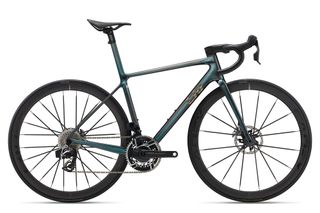
(Image credit: Liv)
The Frame
While they all share the same DNA of the Liv Langma Advanced, the range-topping Advanced SL, understandably, benefits the biggest step change in terms of performance improvements.
The latest race content, interviews, features, reviews and expert buying guides, direct to your inbox!
Fundamentally the whole range shares the same geometry as the previous model, and again, the top-end bikes are limited in size from extra small to medium, while the Langma Advanced Pro and Advanced gain an additional large.
Clarifying its race credentials, the small Liv Langma Advanced Pro 0 that I’ve been riding comes with a reach of 377mm, a stack of 532mm, a 72 degree head angle, 977mm wheelbase and 405mm chainstays.
Our last review of the Liv Langma Advance compared geometry to other brand bikes on the market, but it would seem more pertinent to answer the more obvious questions: is the Langma just a smaller TCR? And, what does an aero facelift mean for the Liv Enviliv, the brand’s aero bike?
The first query is quickly boxed off with a swift look at the TCR confirming that while the two brands may share construction techniques, the framesets are poles apart when it comes to geometry.
The EnviLiv comparison on the other hand is a harder question to answer. Clearly, they are both very different machines, but lining the numbers up next to each other, those differences are marginal.
A longer headtube on the Langma Advance, 120 vs 112mm, leads to taller stack, by just 9mm, and there’s a slightly longer trail on the Langma Advance, 68mm vs 66.3mm.
It’s a revealing set of numbers, which, based on paper alone, leave little to split the two Liv models and does provide food for thought as to what this means for the consumer (or team choice of bike), especially as leading brands move away from differentiating aero and climbing bikes.
Lightweight aero design
While we once had to decide between either going fast on the flat or going fast uphill, aerodynamic design and lightweight construction techniques are so advanced, the gap between aero and climbing is very close to being completely shut.
None more so apparent than in our, hot off-the-press, Race Bike of The Year feature, with us noting that brands are increasingly evaluating ranges, and moving ever closer towards a one-horse strategy when it comes to a hero race bike.
If strong, light and fast are all on the table, why would you only pick two?
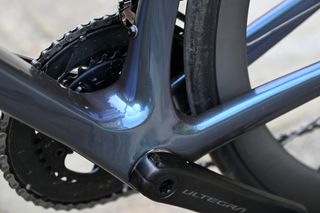
(Image credit: Andy Jones)
It’s the range-topping Langma Advanced SL that gains, and loses, the most in this revamp.
At a glance the SL mirrors the 10th generation Giant TCR construction, inheriting the switch from laser cutting to ‘cold blade’ cutting carbon sheets. At the time Giant said that “this technique is more precise and eliminates the risk of deformation due to excess heat, allowing for fewer pieces of carbon to be used”.
A change to a one-piece monocoque layup with an integrated seatpost, as well as an upgrade in raw carbon material and resin improvements have significantly contributed to weight savings, improved stiffness and an increase in impact resistance from the previous models.
Just how light and stiff can be seen when studying the Liv-supplied dataset. It reveals that this third-generation Liv Langma Advance SL frameset is 123.03g lighter than the previous model, coming in at 1329.69g compared to 1452.63g.
Stiffness-wise, again using the previous model as the benchmark, Liv says the new SL offers a 2.50% increase in pedaling stiffness and a 6.75% increase in torsional stiffness.
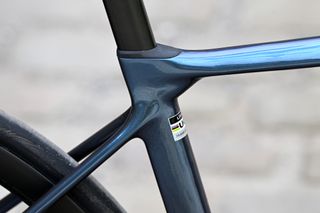
Liv Langma Advance Pro 0’s very neat top tube, seat stay, seat tube and seat post junction
(Image credit: Andy Jones)
The models further down the Langma Advanced range still utilise the previous ‘modified monocoque’ technique. This means a three-piece assembly (tube top, seat tube, down tube) is moulded as one, before the rear half (chainstays and seat stays) are joined in what Liv calls a ‘secondary process’.
This additional processing technique does add a little to the overall weight, ranging between 270.4g and 274.66g more than the SL version depending on the model. Again compared against previous models, there’s a claimed saving of 44g on the Langma Advanced Pro, and 77g on the Langma Advanced framesets.
It also means there’s a stiffness compromise, with 4.12% less pedaling stiffness for the Advanced Pro, and 8.09% for the Advanced, plus 3.81% and 11% less torsion accordingly.
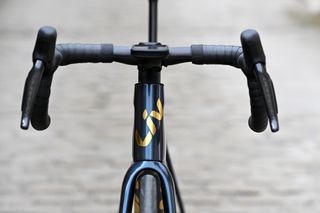
The Liv Langma Advanced Pro 0’s front end is now very tidy.
(Image credit: Andy Jones)
Aero optimisations
The front end of the bike is where I’m, personally, most delighted by the update. The messy nest of cables has gone. Arguably integrated cabling is just passing the headache on to mechanics to deal with, but from an aero and aesthetic standpoint, this non-cluttered approach to cable porting has been long overdue.
Cockpit-wise, again this depends on the Liv Langma Advanced model selected, but it includes the recently redesigned Giant Contact SLR/SL AeroLight stem and new flared Liv Contact SLR/SL handlebar with internal cable routing.
This does limit options to own brand, but I am assured that there is carbon or alloy to choose from and plenty of sizes to suit all rider requirements.
The last element to focus under the bike launch lens is the wheel and tyre combination.
This is a big update for the Liv Langma Advance in general with a jump to the Giant SLR 1 40mm hookless wheelset, to an even deeper rim from the previous models, which were equipped with a 36mm version.
The other upgrade here is the move to the Giant Gavia Course 0, tubeless, 700x25c (28mm when inflated) tyres, although Liv say that there is up to 33mm of tyre clearance, a marginal gain of around 2mm on the previous version.
Again, both these changes are in sync with the Giant TCR updates, where you can read more about the impact of wheels and tyre choice on aerodynamic drag, and comparisons across other wheel system platforms.
Bundling all the Langma Advanced improvements together and looking once more at the Liv-produced datasets, the bottom line reveals a marked improvement all round on the reduction of drag.
Even with what the brand refers to as real-world testing, two water bottles and dynamic rider in the wind tunnel, the top-end Langma Advance SL saves nearly 13 watts when hitting 40kph compared to the previous version.
Unpicking this dataset to verify is near impossible. Liv use the previous Langma Advanced SL wattage of 256.27 and compare it to the new SL wattage of 243.7 to evidence this kind of power saving.
Using incredibly crude back-of-an-envelope maths, it would appear that if two riders set off on both new and old versions of the Liv Langma Advanced SL to complete a 25mile (40km) time trial, the rider on the new version would finish over a minute quicker, with a time of around 58.52. In other words it’s 0.77km/h faster.
But this does bring me back to the theoretical quandary between the Liv Langma Advance and EnviLiv.
I agree, I’m not comparing apples with apples. The EnviLiv is a dedicated aero race bike, and its tubing profiles alone highlight this categorization. I’d need to do some proper empirical data testing to truly cite which was the fastest in any given set of circumstances, but I can’t help but wonder if the suggested watt and weight saving spells the end for the Liv EnviLiv.
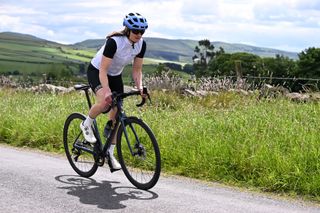
Out in the hills on the Liv Langma Advance Pro 0.
(Image credit: Andy Jones)
First Ride
It’s been six years since I last rode the Liv Langma, and hopping on board again is making me realise that it’s been far too long.
I’ve had about a week with the Liv Langma Advanced Pro 0, and from the very first pedal stroke I was, again, instantly smitten, reminding me why I originally rated it as worthy of an Editors Choice Award.
Climber, sprinter, aero – yet again this bike delivers all in spades.
As a do-all bike, it’s easy to ride with a point-and-shoot attitude, allowing me to forget my less-than-race pedigree fitness status.
After testing out the braking efficiency with a couple of instant descents, I swiftly realised how naturally the bike oozes capability, the Shimano Ultegra Di2 does help here. There’s no way that I would normally throw myself down the Peak District declines within the first couple of miles of a test ride.
It’s a testament to the holistic Langma Advanced Pro 0 platform that I instinctively trusted the bike’s setup, and felt safe. Of course, the wheels and tyres play a huge role in this confidence-inspiring ride feel.
The Giant SLR 40 wheelset, shod in the Cadex Race GC Tubeless tyres, seems to be the perfect partnership. I’m a bit of a tyre nerd, and while I like to feel probably more road feedback than most, I also don’t want to suffer eyeball vibration.
This wheel/ tyre combo appears to have nailed that sweet spot, providing me with enough of a surefooted sensation, while also being malleable when leant over or on the questionable road surfaces that most highways in the UK seem to be peppered with.
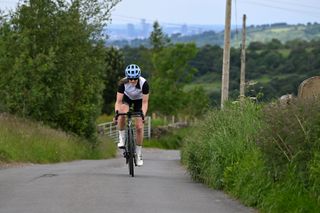
Liv Langma Advanced Pro 0 first ride, with Manchester on the skyline
(Image credit: Andy Jones)
My concerns about side winds whipping the 40cm deep wheels with bladed spokes didn’t come to fruition. I didn’t seem to suffer anywhere near as much buffering as I was predicting.
Even on pretty gusty rides in the hills, and into Manchester City Centre where wind tunnelling effects can catch even the most experienced rider off guard. I wouldn’t say I was ready to ride hands-free to don a raincoat, but I certainly didn’t notice any snatching.
The frameset of course also plays a huge role in the ride feel and I’m pleased it’s carried over geometry from the previous model, which was so well executed.
It still delivers such a pinging ride. Like a shaken-up can of fizzy pop, the bike feels urgent and explosive, immediately making me tackle some of the more gruesome local climbs that I normally want to avoid.
My initial ‘going for a spin’ ride was suddenly a surprisingly easy 30 miles in the hills, and I’ve not wanted to stop riding Langma since, despite one of the coldest starts to June, it’s constantly luring me out to ride.
And then there’s the Liv Langma’s good looks.
Even the most stoic of hearts would be hard not to appreciate these. I personally think it’s the closest rival to the Wilier Filante in the Pro Peloton. Hand on heart I’d honestly struggle to choose between them if forced to pick just one.
The Liv Langma Advanced Pro 0 is comfortable, rapid, lightweight, sure-footed, agile… all the superlatives and more. Which just begs the question, why does the brand even bother with the EnviLiv?
Models and Pricing
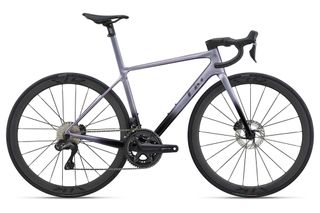
(Image credit: Liv)
The top-end Liv Langma Advanced SL 0 is specced in the new SRAM Red AXS with integrated power meter, Cadex Max 40 wheels and Race GC tyres and Contact SLR bars and stem. Top end does mean top price tag too, with this model setting riders back £11,999/ $12,500
Keeping the same frameset and finishing kit, the Advanced SL 1 just has a drive train swap out to Shimano Ultegra Di2 and a Giant Power Pro power meter. These compromises do add up, assuming you’re in the UK that is.
The RRP drops to £8,999 for the SL1, but unfortunately, this model isn’t available in the USA.
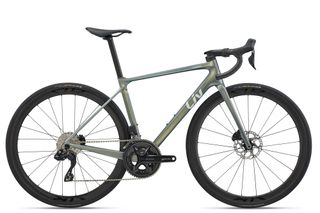
LIV Langma Advanced Pro 1
(Image credit: Liv)
Next in line is the Langma Advanced Pro 0, the bike I’ve been riding. The big change here is the frameset swaps to the modified monocoque construction technique and the loss of the integrated seat post. But other than that it keeps the same spec as the Advanced SL1 and costs £6,499/ $6,500.
Marginally below the Pro 0 sits the Advanced Pro 1. This keeps the same frameset and wheel system as the Pro 0, but swaps out to either SRAM Rival AXS with a Giant Power Halo power meter for £4,999, or Shimano 105 Di2 and Giant Power Pro power meter for £4,899, both moving to a Liv Contact SL handlebar. The Pro 1 isn’t available in the USA.
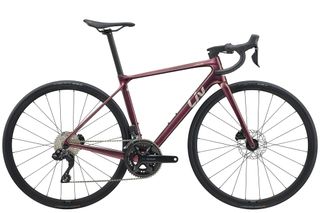
(Image credit: Liv)
Completing the range is the Langma Advanced 0, 1 and Advanced 2.
The Advanced 0 keeps a similar setup to the Advanced Pro 1, ditching the power meter and swopping the bar to a Liv Contact, and the deep section wheels for Giant SLR 2 36 wheel system in Giant Gavia Course 1 tyres. The price tag comes in at $4,700, with the UK losing out on the Advanced 0 availability.
The Advanced 1 again keeps a lot of similarities to the Advanced Pro 1, but this time loses the power meter, swaps the bar to a Liv Contact, drops the Shimano rotors and chain for Giant own brand and KMC accordingly, and loses the deep section wheels for Giant P-R2 shod in Giant Gavia Course 1 tyres. This comes in at £3,199.
The Advanced 2 follows suit, but leaves the digital shifting in favour of mechanical 105 for £2,699/ $3,200

